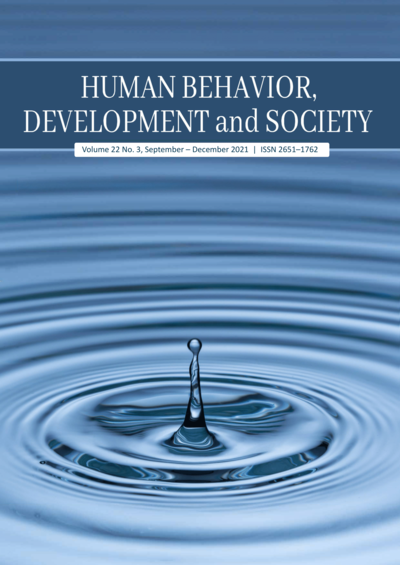The Iban of Sarawak, Malaysia: Ethnic Language Losing Ground to English and Sarawak Malay
Main Article Content
Abstract
Language use by the Iban people in Sarawak, Malaysia, was studied and the focus was on the following specific objectives: (a) to describe the language use patterns of the Iban people in Iban dominant and non-Iban dominant areas in nine domains and (b) to identify the stable domains of language use for the Iban language. The data were from 84 Iban respondents, elicited using a questionnaire designed based on the UNESCO framework. The percentage of Iban usage was higher in Iban-dominant areas (30%–70%) than in non-Iban dominant areas (10%–60%). The results revealed that there was intergenerational language transmission but English was encroaching into family communications involving spouse and children. Furthermore, the usage of Iban was dwindling outside the family domain. In particular, Iban was losing ground to English in four domains (friends, classmates, workmates, and prayers) and to Sarawak Malay in two domains (public places, and market). In non-Iban dominant areas, the results on languages used in public places and in new domains (social media communication) indicate that domains of language use currently occupied by Iban may be taken over by English and Malay in the future with more ethnically-mixed family, friendship, work, and public spaces.
Article Details

This work is licensed under a Creative Commons Attribution-NonCommercial-NoDerivatives 4.0 International License.
Copyright: Asia-Pacific International University reserve exclusive rights to publish, reproduce and distribute the manuscript and all contents therein.
References
Bourhis, R. Y., Giles, H., & Rosenthal, D. (1981). Notes on construction of a “subjective vitality questionnaire” for ethnolinguistic groups. Journal of Multilingual and Multicultural Development, 2, 145–155. https://doi.org/10.1080/01434632.1981.9994047
Brenzinger, M., Dwyer, A. M., Graaf, T., Grinevald, C., Krauss, M., Miyaoka, O., Ostler, N., Sakiyama, O., Villalón, M. E., Yamamoto, A. Y., & Zapeda, O. (2003, March 10–12). Language vitality and endangerment. International Expert Meeting on UNESCO Programme Safeguarding of Endangered Languages; Paris, France. https://pure.mpg.de/rest/items/item_1468187/component/file_1468185/content
Chuchu, F., & Noorashid, N. (2015). The vitality and revitalisation of minority languages: The case of Dusun in Brunei Darussalam. International E-Journal of Advances in Social Sciences, 1(1), 34–46. https://doi.org/10.18769/ijasos.28921
Coluzzi, P. (2010). Endangered languages in Borneo: A survey among the Iban and Murut (Lun Bawang) in Temburong, Brunei. Oceanic Linguistics, 49(1), 119–143. https://doi.org/10.1353/ol.0.0063
Coluzzi, P. (2016). Levels of vitality and efforts to maintain Bidayuh and Mah Meri. Southeast Asia: A Multidisciplinary Journal, 16, 39–47. https://fass.ubd.edu.bn/SEA/vol16/SEA-v16-coluzzi.pdf
Coluzzi, P., Riget, P. N., & Wang, X. (2017). Language vitality among the Orang Asli of Malaysia: The case of the Mah Meri on Telo’ Gunjeng (Carey Island, Selangor). International Journal of the Sociology of Language, 244, 137–161. https://doi.org/10.1515/ijsl-2016-0060
DOSM (Department of Statistics, Malaysia). (2017). Sarawak population by district 2017. https://data.sarawak.gov.my/home/data/resource_download/709
Fishman, J. A. (1997). The sociology of language. In N. Coupland & A. Jaworski (Eds.), Sociolinguistics (pp. 25–30). Springer.
Giles, H., Bourhis, R.Y., & Taylor, D. M. (1977). Towards a theory of language in ethnic group relations. In H. Giles (Ed.), Language, ethnicity and intergroup relations (pp. 307–348). Academic Press. https://www.researchgate.net/publication/265966525
Hair, J. F. J., Black, W. C., Babin, B. J., & Anderson, R. E. (2014). Multivariate data analysis (7th ed.). Pearson Education.
Hamers, J. H., & Blanc, M. H. (1989). Bilinguality and bilingualism. Cambridge University Press.
Igbaria, M., Parasuraman, S., & Badawy, M. K. (1994). Work experiences, job involvement, and quality of work life among information systems personnel. MIS Quarterly, 18(2), 175–201.
Joan, A., & Ting, S. H. (2016). Hierarchies of language status: Of Kejaman, Iban, Malay and English. In M. Basri, M. S. M. Salleh, & S. B. Ahmad (Eds.), Proceedings of the 4th International Conference on Social Sciences Research 2016 (ICSSR 2016) (pp. 32–41). Kuala Lumpur, Malaysia: World Conference Resources.
Kijai, J., Lampadan, R., & Loo, D. B. (2012). Factors related to language shift among the Tindal population in Ratau, Kota Belud, Sabah. Catalyst, 7(1), 4–13. https://so01.tci-thaijo.org/index.php/hbds/article/ download/ 172410/123739
Landry, R., & Allard, R. (1994). Ethnolinguistic vitality: A viable construct. International Journal of the Sociology of Language, 108, 5–13. https://icrml.ca/en/research-and-publications/references/item/78633-introduction-ethnolinguistic-vitality-a-viable-construct
Lewis, M. P., & Simons, G. F. (2010). Assessing endangerment: Expanding Fishman’s GIDS. Revue Roumaine de Linguistique/Romanian Review of Linguistics, 55(2), 103–120.
McLellan, J. (2014). Strategies for revitalizing endangered Borneo languages: A comparison between Negara Brunei Darussalam and Sarawak, Malaysia. Southeast Asia: A Multidisciplinary Journal, 14, 14–22. https://fass.ubd.edu.bn/SEA/vol14/SEA-v14-mclellan.pdf
Mohamed, N., & Hashim, N. H. (2012). Language vitality of the Sihan community in Sarawak. Kemanusiaan, 19(1), 59–86. http://web.usm.my/kajh/vol19_1_2012/KAJH19_1_2012_4.pdf
Omar, A. H. (1981). The Iban language of Sarawak: A grammatical description. Dewan Bahasa dan Pustaka.
Philip, B. (2017). Trajectories in the development of the Iban language of Sarawak: In retrospect and looking beyond. In N. T. E. Unting, & N. Belawing (Eds.), International Conference on Iban Language and Ethnography (ICILE 2017): “Ngenegap ka jaku enggau daya idup Iban” (pp. 72–85). Institut Pendidikan Guru Kampus Sarawak.
Sutlive, V. (1994). Handy reference dictionary of Iban & English. Tun Jugah Foundation.
Ting, S. H., & Campbell, Y. M. (2017). The role of indigenous languages in schools: The case of Sarawak. In M. Samuel, M. Tee, & L. Symaco (Eds.), Education in Malaysia: Development and challenges (pp. 119–136). Springer Nature. https://doi.org/10.1007/978-981-10-4427-4_8
Ting, S. H., & Tensing, F. (2010, July 5–7). Focal points of grammar teaching in secondary school Iban textbooks [Paper presentation]. In the 10th Biennial Borneo Research Council (BRC 2010) International Conference, Miri, Sarawak, Malaysia.
Ting, S. H., Tinggang, A., & Metom, L. (2021). Language use and attitudes as indicators of subjective vitality: The Iban of Sarawak, Malaysia. Language Documentation and Conservation, 15, 190–218. https://scholarspace.manoa.hawaii.edu/bitstream/10125/24973/ting_et_al.pdf
Tsunoda, T. (2005). Language endangerment and language revitalization: An introduction. Mouton de Gruyter.
Umbat, J. (2020, November 21). Punca kemerosotan bahasa Iban [Audio podcast]. Sarawak Voice. https://sarawakvoice.com/2020/11/21/punca-kemerosotan-bahasa-iban/
Wan, R., Renganathan, S., & Philip, B. (2015). What is the point of us talking? Ethnic language and ethnic identity in Northern Borneo, Malaysia. Humanities and Social Sciences Review, 4(1), 109–120. https://www.researchgate.net/publication/277013818_WHAT_IS_THE_POINT_OF_US_TALKING_ETHNIC_LANGUAGE_AND_ETHNIC_IDENTITY_IN_NORTHERN_BORNEO_MALAYSIA


